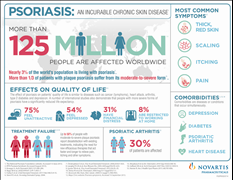Feature

· CLEAR study at AAD showed over 21% more psoriasis patients achieved clear to almost clear skin (PASI 90) with Cosentyx™ compared to Stelara® at Week 161
· Cosentyx showed greater improvements to Stelara across all study endpoints up to Week 16, including PASI 100 and onset of action1
· PASI 90 and PASI 100 are both considered important measures of treatment success for psoriasis patients, demonstrating clear to almost clear skin2,3
· Cosentyx, the first and only IL-17A inhibitor approved for psoriasis, has now shown superiority to both Stelara and Enbrel®, widely used biologic treatments1,4
Basel, March 20, 2015 – Novartis announced today results from the CLEAR study demonstrating that Cosentyx™ (secukinumab) is significantly superior to Stelara®* (ustekinumab), a widely used biologic, in achieving clear or almost clear skin for psoriasis patients1. The detailed findings were presented in a late-breaking research session at the 73rd Annual Meeting of the American Academy of Dermatology (AAD) in San Francisco, USA. Cosentyx (at a dose of 300 mg) is the first and only interleukin-17A (IL-17A) inhibitor approved to treat adult patients with moderate-to-severe plaque psoriasis.
In this Phase IIIb study, Cosentyx met the primary endpoint of showing superiority to Stelara as assessed by the Psoriasis Area Severity Index (PASI) 90 response, known as clear to almost clear skin2, at Week 16 (79.0% vs. 57.6%, P<0.0001)1. PASI 90 is considered an important measure of treatment success by the European Medicines Agency2 and an optimal treatment goal for patients3. In addition, completely clear skin (PASI 100) at Week 16 was achieved by significantly more patients treated with Cosentyx than those receiving Stelara (44.3% vs. 28.4%, P<0.0001)1.
“The robust results from the CLEAR study further demonstrate how Cosentyx is changing the way psoriasis is treated and helping patients achieve clear skin,” said Vasant Narasimhan, Global Head of Development, Novartis Pharmaceuticals. “With Cosentyx now approved in many countries around the world, we are committed to helping psoriasis patients significantly improve their overall quality of life.”
In addition, Cosentyx demonstrated rapid onset of action and greater efficacy at all time points in the study up to Week 16, with 50% of Cosentyx patients achieving PASI 75 as early as Week 4 compared to Stelara (50.0% vs. 20.6%, P<0.0001)1. The safety profile of Cosentyx was comparable to Stelara and consistent with previously reported Phase III clinical trials for Cosentyx1,4-6.
About the CLEAR study
CLEAR (Comparison to assess Long-term Efficacy, sAfety and toleRability of secukinumab vs. ustekinumab), a 52-week, multicenter, randomized, double-blind study, is a head-to-head Phase IIIb study initiated with Cosentyx, and compares the efficacy, long-term safety and tolerability of Cosentyx (secukinumab) versus Stelara (ustekinumab), in patients with moderate-to-severe plaque psoriasis1. Twenty-four countries across North America, Europe, Asia and Australia participated in the study, with enrollment reaching 679 patients in record time1.
The primary endpoint measured at Week 16 is PASI 901. PASI 90 is considered a more robust measure of the extent of skin clearance compared to the standard efficacy measures used in most psoriasis clinical studies, such as PASI 75. Additionally the secondary endpoint measured at Week 4 is PASI 751. PASI 100 at Week 16 was one of the exploratory endpoints1. Week 52 data will follow in due course.
The CLEAR study follows the pivotal Phase III FIXTURE study, which showed Cosentyx was superior to Enbrel®** (etanercept) in clearing skin4. Results from the FIXTURE study were first announced in October 2013.
About Cosentyx (secukinumab) and interleukin-17A (IL-17A)
Cosentyx is a human monoclonal antibody that selectively neutralizes interleukin-17A (IL-17A)7,8. IL-17A is found in high concentrations in skin affected by psoriasis and is a preferred target for investigational therapies7-12. Cosentyx works by inhibiting the action of IL-17A, a protein found in high concentrations in skin affected by the disease7-12. In the Phase III program, Cosentyx demonstrated a favorable safety profile, with similar incidence and severity of adverse events between Cosentyx treatment arms (300 mg and 150 mg)1,4-6.
In January 2015, Cosentyx (at a dose of 300 mg) became the first and only interleukin-17A (IL-17A) inhibitor approved in Europe as a first-line systemic treatment of moderate-to-severe plaque psoriasis in adult patients, and in the US as a treatment for moderate-to-severe plaque psoriasis in adult patients who are candidates for systemic therapy or phototherapy (light therapy). In addition to the EU and the US, Cosentyx has been approved in Switzerland, Chile, Australia, Canada and Singapore for the treatment of moderate-to-severe plaque psoriasis and in Japan for the treatment of moderate-to-severe plaque psoriasis and active psoriatic arthritis (PsA).
Cosentyx is also in Phase III development for PsA and ankylosing spondylitis (AS); global regulatory applications are planned for 2015.
About Psoriasis
Psoriasis is a chronic immune-mediated disease characterized by thick and extensive skin lesions, called plaques, known to cause itching, scaling and pain; it is associated with significant impairment of physical and psychological quality of life13-15. Psoriasis affects up to 3% of the world’s population, or more than 125 million people16.
This common and distressing condition is not simply a cosmetic problem – even people with very mild symptoms are affected everyday13. According to an analysis of surveys conducted of 5,600 patients by the National Psoriasis Foundation (NPF) between 2003 and 2011, 52% of patients with mild, moderate and severe psoriasis were dissatisfied with their disease management17. Of the patients surveyed, some were receiving no treatment (9.4-49.2%) or were undertreated (10.2-55.5%)17.